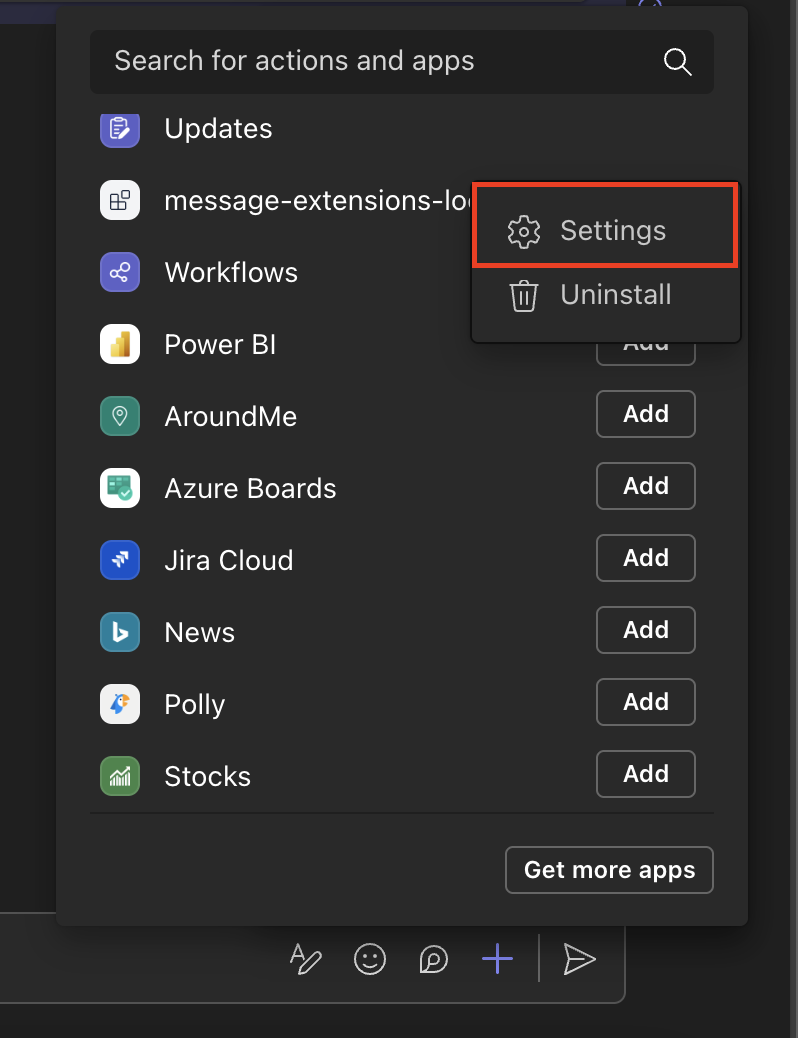⚙️ Settings
You can add a settings page that allows users to configure settings for your app.
The user can access the settings by right-clicking the app item in the compose box

This guide will show how to enable user access to settings, as well as setting up a page that looks like this:

1. Update the Teams Manifest
Set the canUpdateConfiguration field to true in the desired message extension under composeExtensions.
"composeExtensions": [
{
"botId": "${{BOT_ID}}",
"canUpdateConfiguration": true,
...
}
]
2. Serve the settings html page
This is the code snippet for the settings html page:
<!DOCTYPE html>
<html>
<head>
<title>Message Extension Settings</title>
<link rel="stylesheet" href="https://stackpath.bootstrapcdn.com/bootstrap/4.5.0/css/bootstrap.min.css">
<script src="https://statics.teams.cdn.office.net/sdk/v1.11.0/js/MicrosoftTeams.min.js"></script>
<style>
body { margin: 0; padding: 10px; }
.form-group { margin-bottom: 10px; }
</style>
</head>
<body>
<div class="container">
<h3>Message Extension Settings</h3>
<form id="settingsForm">
<div class="form-group">
<label>Selected Option:</label>
<select class="form-control" id="selectedOption" name="selectedOption">
<option value="">Please select an option</option>
<option value="option1">Option 1</option>
<option value="option2">Option 2</option>
<option value="option3">Option 3</option>
</select>
</div>
<button type="submit" class="btn btn-primary">Save Settings</button>
</form>
</div>
<script>
microsoftTeams.initialize();
// Get the selectedOption from URL parameters
const urlParams = new URLSearchParams(window.location.search);
const selectedOption = urlParams.get('selectedOption');
if (selectedOption) {
document.getElementById('selectedOption').value = selectedOption;
}
document.getElementById('settingsForm').addEventListener('submit', function(event) {
event.preventDefault();
let selectedValue = document.getElementById('selectedOption').value;
microsoftTeams.tasks.submitTask(selectedValue);
});
</script>
</body>
</html>
Save it in the index.html file in the same folder as where your app is initialized.
You can serve it by adding the following code to your app:
app.page("settings", str(Path(__file__).parent), "/tabs/settings")
This will serve the HTML page to the ${BOT_ENDPOINT}/tabs/settings endpoint as a tab.
3. Specify the URL to the settings page
To enable the settings page, your app needs to handle the message.ext.query-settings-url activity that Teams sends when a user right-clicks the app in the compose box. Your app must respond with the URL to your settings page. Here's how to implement this:
@app.on_message_ext_query_settings_url
async def handle_message_ext_query_settings_url(ctx: ActivityContext[MessageExtensionQuerySettingUrlInvokeActivity]):
user_settings = {"selectedOption": ""}
escaped_selected_option = user_settings["selectedOption"]
bot_endpoint = os.environ.get("BOT_ENDPOINT", "")
settings_action = CardAction(
type=CardActionType.OPEN_URL,
title="Settings",
value=f"{bot_endpoint}/tabs/settings?selectedOption={escaped_selected_option}",
)
suggested_actions = MessagingExtensionSuggestedAction(actions=[settings_action])
result = MessagingExtensionResult(type=MessagingExtensionResultType.CONFIG, suggested_actions=suggested_actions)
return MessagingExtensionInvokeResponse(compose_extension=result)
4. Handle Form Submission
When a user submits the settings form, Teams sends a message_ext_setting activity with the selected option in the activity.value.state property. Handle it to save the user's selection:
@app.on_message_ext_setting
async def handle_message_ext_setting(ctx: ActivityContext[MessageExtensionSettingInvokeActivity]):
state = getattr(ctx.activity.value, "state", None)
if state == "CancelledByUser":
result = MessagingExtensionResult(
type=MessagingExtensionResultType.RESULT, attachment_layout=AttachmentLayout.LIST, attachments=[]
)
return MessagingExtensionInvokeResponse(compose_extension=result)
selected_option = state
await ctx.send(f"Selected option: {selected_option}")
result = MessagingExtensionResult(
type=MessagingExtensionResultType.RESULT, attachment_layout=AttachmentLayout.LIST, attachments=[]
)
return MessagingExtensionInvokeResponse(compose_extension=result)